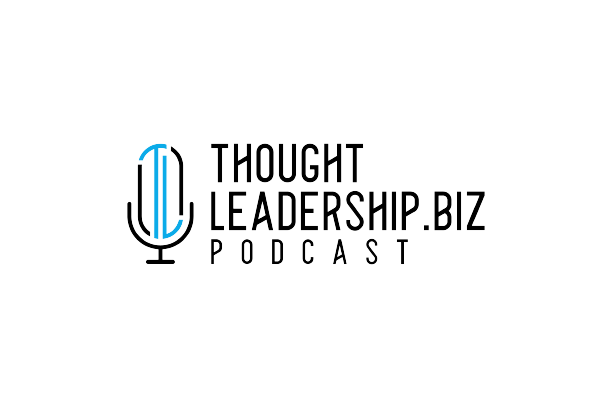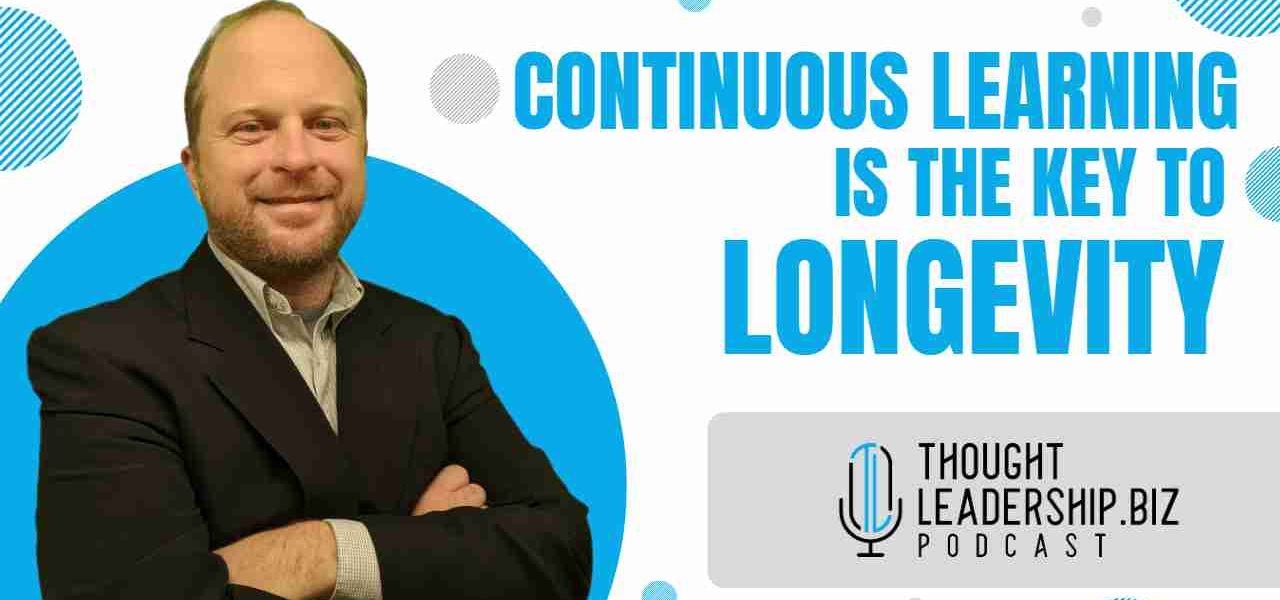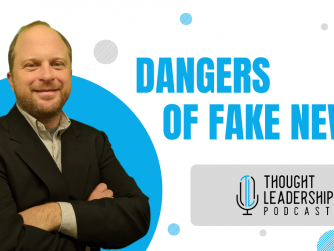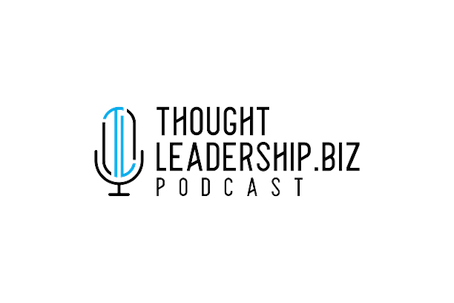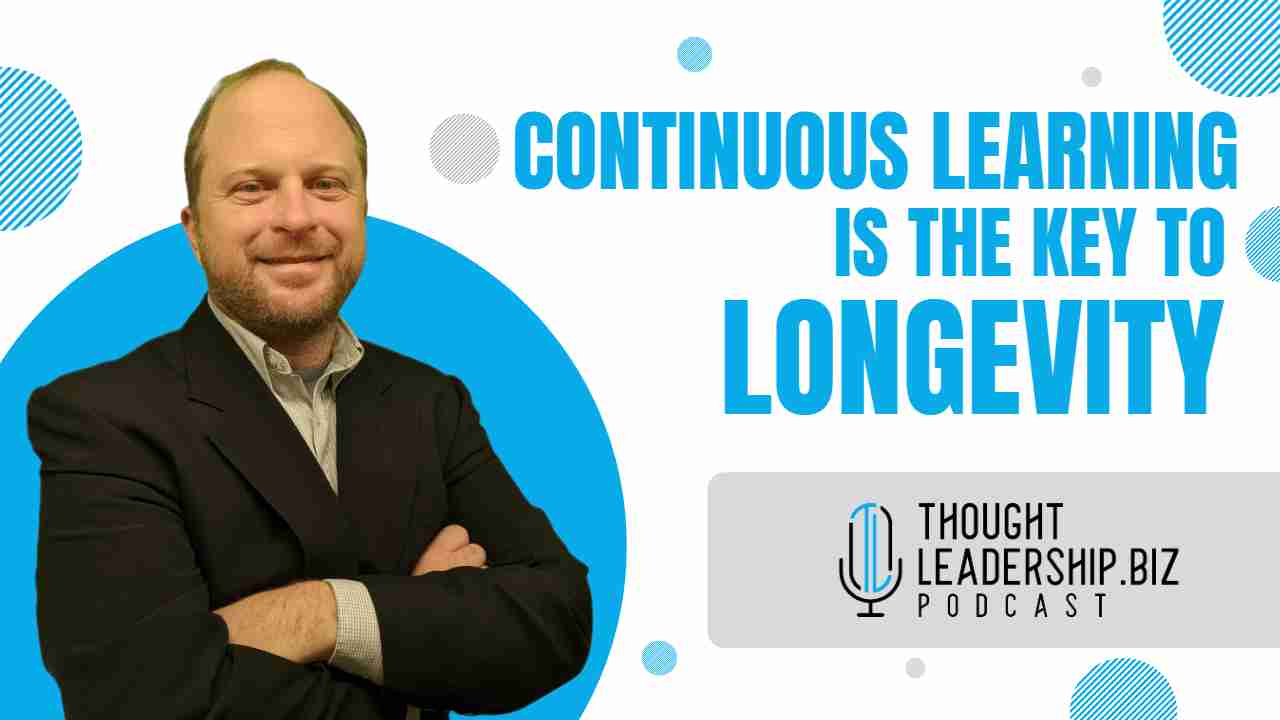
Read / Watch / Listen
Stream this article from your favorite podcast audio or video streaming service as referenced below.
Read: Below
Watch: https://youtu.be/EUX2v1xR6Rk
Listen: Continuous Learning is the Key to Longevity
More ways to read, watch and listen
Read the Article
Hi everyone, and welcome to another stimulating episode of ThoughtLeadership.biz. I’m Chris Machut and in today’s show we’ll be looking at why it’s important to keep learning, even when you think you know it all – especially when you think you know it all. . .
As Steve Jobs once said, “Innovation distinguishes between a leader and a follower.” And he was right.
It’s that ability to innovate – the ability to continually draw ideas from a deep reservoir of knowledge and skills, and ignite them with vigor and flair – that puts new business on the map and keeps the established ones at the front of the pack.
And it’s from the well of Continuous Professional Learning (CPL) that these ideas are drawn and within organizations that promote it where we see some of the most dynamic and influential ideas, innovations and changes.
So, if your business isn’t already deeply embroiled in a passionate affair with CPL (Continuous Professional Learning), then you’d better start preparing for the Singles Club because before you know it, you’ll be all on your own.
CPL is a crucial element in the success of any serious, large-scale business in the 21st century, where adaptability and innovation are more important than ever before. The fact of the matter is, if you can’t see a future for CPL in your company, then the likelihood is that there’s not much of a future for your company at all.
*****
Before we get into the nitty-gritty, let me remind you to check out all my newest articles, podcasts and more at ThoughtLeadership.biz, catch me in person on YouTube or listen to my dulcet tones via Spotify and Anchor.fm. You’ll also find me on Apple and Google Podcasts, as well as Twitter and LinkedIn, where you can subscribe for notifications.
*****
Alrighty then. So, if CPL is such a thing and so important for longevity, why do so many organizations still overlook it?
Before we answer that question, and then have a look at some keys ways you can introduce a continuous learning culture into your business, let’s define what Continued Professional Learning actually is.
And that’s pretty simple, really: It’s the ongoing process of developing, maintaining and documenting your professional skills.
As a leader, your job description is pretty simple, too:
- Challenge your teams and encourage them to plan and undertake their own professional learning journeys, so that they can effectively analyze, adapt and pivot in response to the latest trends and changes.
- Empower them to actively use their knowledge and skills to realize your company’s mission and values.
- Recognize their efforts, progression and success in a suitable way.
- Lead by example.
That’s pretty much it.
Now, you don’t have to be a world-class business leader to understand that in order to be successful in an unpredictable, rapidly evolving and cut-throat business environment, having a well-trained team who are motivated and at the forefront of the latest thinking in your sector is essential.
But even now, given everything we’ve been through in the last couple of years, a staggering amount of so-called leaders do.
The official term for this type of critical oversight is Dead-Dodo Syndrome. . . Okay, I just made that up – but it works, because the only reason the dodo ended up going extinct was that it failed to keep up with changes to its environment.
It failed to recognise the threat of hundreds of hungry armed European settlers with very large guns and very excited dogs. It’s kinda surprising, I guess – but what happened as a result isn’t.
And businesses are much the same: Ignore the threats, fail to move with the times and you’re as dead as a dodo.
The most surprising thing is that although every successful company knows that its workforce is absolutely crucial for its success, they still cling desperately to outdated development models because, just like the dodo, they fail to see the emerging threats and the potentially disastrous futures they represent.
Instead of seeing professional learning as something essential for success and then intrinsically weaving it into the fabric of who they are and what they do, they still see ‘professional development’ as a single-event experience and, more often than not, a tick box exercise.
More progressive companies do things differently. They see the writing on the boardroom wall and adapt as necessary.
They understand that it’s survival of the fittest and that being the fittest means continually upskilling and motivating their teams, so that the organization can thrive as they explore new frontiers of business.
Instead of stubbornly conforming to outdated models and practices, they are intensely interested in transforming and future-proofing their company, ensuring it has its finger firmly pressed on the professional pulse and a team of employees who are actively engaged in learning the skills they need to pursue their professional goals.
These companies understand very clearly that in doing so they create trust, motivation and shared confidence within the organization, as well a much higher likelihood that the employees will contribute directly to the company’s future success.
Alright, so there’s the situation in a tiny little nutshell.
Now, let’s have a quick look at three key benefits to developing a continuous learning culture.
*****
- Bridge the Skills Gap
Companies who follow traditional ways of operating usually fill the skills gap by employing new people. For example, full-time staff will be employed to fill the bigger long-term holes, while contractors might be drafted in for the short- or medium-term, etc. etc.
But progressive companies do it differently. Instead of paying full-time or part-time salaries and dealing with all the other associated costs of onboarding new employees, they cultivate a continuous learning culture, often via online learning platforms (or MOOCs), such as Coursera, edX or Simplilearn, which reduce associated overheads considerably.
By utilizing these online options, existing employees can train themselves up with the skills and knowledge necessary in order to fill these new roles and, crucially, do so at their own pace.
Given the fact that almost a third of new employees throw in the hat within the first six months, this strategy makes massive sense financially and logistically.
- Create a Competitive Edge
As I’ve said already, companies that cultivate a continuous learning culture and actively encourage their staff to try out new ideas usually excel in their sector and leave the dodos dead in the sand.
If you’re in sales, for example, this can be a huge advantage. Some of the research suggests that CPL can not only increase productivity in general but also contribute up to a whopping 50% increase in net sales per employee – and who doesn’t want that, right?!
Enough said.
Alright, so on to benefit three.
- Establish an Enriching Work Environment
When a company decides to take a deep dive with CPL and establish then cultivate a continuous learning culture, so many aspects of the day-to-day organizational experience get a huge boost.
The workforce becomes more productive as the environment immediately becomes more dynamic, purposeful and motivational.
Furthermore, with recognition and rewards being bestowed on those who rise to the challenges, the learning culture spreads organically, wedding out those who are better off somewhere else and extending and enriching those who buy into it.
Over time, the culture you’ve created automatically transforms and expands the capacity of individuals to carry out more demanding and innovative roles, which eventually elevates your brand and increases both your visibility and influence in the marketplace.
It also discourages the silo-mentality, promotes cross-pollination of skills and knowledge, encourages loyalty, creates cohesion and unifies the organization as a whole, especially when the positive data and accolades start rolling in. . .
*****
I don’t know about you, but all of that sounds pretty positive to me. And the beauty of it is, as a leader the return on the investment is HUGE – and it’s relatively easy to accomplish, too.
All you need is vision, confidence and trust in your team. . .
So, if you haven’t seriously considered it yet, my advice is take a good look at Continuous Professional Learning today – because if you don’t, your business might end up dead as a dodo tomorrow.
This is Chris Machut.
See you next time – and keep learning out there!
Latest posts by ThoughtLeadership (see all)
- Episode 24 – The Crypto Cake CEX vs DEX - January 27, 2023
- Episode 23 – Blockchain Basics - December 16, 2022
- Episode 22 – Be Alpha - November 18, 2022


